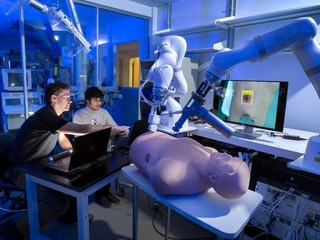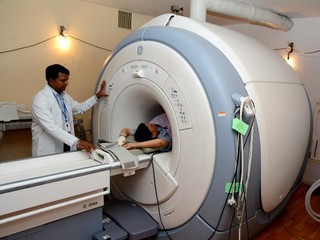The company building the outdoor lodging brand
WeChalet curates places to stay for nature and adventure enthusiasts
Read more...
Time, or in the case of healthcare, testing is of the essence, which is particularly difficult when the point of access is a specific testing center far removed from the doctor and patient. This gap is closing as remote screening and biometric devices increasingly become available in the home or doctors’ offices. Heightening the awareness of these new tools is the novel coronavirus, which has, as most crises do, revealed areas of vulnerabilities that need to be rapidly addressed.
One area of testing vulnerability is in imaging, where access to MRIs can give doctors and patients more immediate answers to make timely decisions. Yet today the average wait time for an MRI is over a week. If you have a torn ligament or a tumor, waiting more than a week can feel like a lifetime. Making matters worse, once the results are in, diagnostics can be off. Some 12 million Americans are misdiagnosed each year, and nearly a third result in serious injury or death for the patient.
Advances in artificial intelligence and hardware are enhancing our medical imaging capabilities. We know this first hand as we are innovating on both fronts with my company Promaxo, which has developed an in-office MRI. From a macro level, financiers of this industry are also seeing these new technologies applied specifically to modernizing workflows and bringing the point of care closer to the patient. These are essential life-saving advances that we are committed to pursuing at Promaxo and fortunately so are influencers in this space.
Solving the workflow problem
Already a third of hospitals and imaging centers are using AI to help with patient care imaging or business operations, according to a survey from Definitive Healthcare. Meanwhile, AI in medical imaging is expected to grow 10x in less than a decade to $265 billion in 2026 from $21 billion in 2018.
AI is already producing more accurate results than radiologists. A study conducted in part by Google Health looked at X-ray imaging using AI to review the images of 29,000 women with known breast cancer diagnoses. The AI-imaging system reduced false negatives by 9.4 percent and lowered false positives by 5.7 percent. A false positive inadvertently indicates a condition exists. A false negative inadvertently shows a condition doesn’t exist.
These advances are coming at an opportune time as the industry sees a reduction of staff trained in this specialty.
“In the last decade or so, the need for AI has been more urgent because of the shortage of radiologists, partly due to burnout. Now we can ease their workload because machine learning is being applied to the increased data we're collecting at much cheaper and faster rates," said Shruti Gandhi, founder and managing partner at Array Ventures, which invested in Rad AI, a startup that uses machine learning and artificial intelligence to automate the most repetitive parts of a radiologist’s job.
“Now is the time to take those advances and make the radiologist more efficient, assisting them in catching errors and also helping them understand patterns in case they miss something. The technology can allow them to quickly look things up right in their workflow, so it’s not just a tool to help them process images, it also makes their workflow faster. That's where you can really make a difference in the field.”
Indeed, the ability to access knowledge quickly would transform this industry. Currently, after a scan is done, the workflow involves sending images to a radiologist to interpret and annotate the suspicious regions for diagnosis and treatment planning. A lot of this dirty work on basic interpretation and annotation could be performed by AI instead, to enable computer aided diagnosis as well as tissue characterization.
The other way that artificial intelligence can help the workflow is through better precision.
There are seven common patterns of AI that often repeat themselves when building up an artificial intelligence solution, include: hyper personalization, which creates a unique profile of each individual; autonomous systems, which can operate without human involvement; predictive analytics and decision support, which can help predict future outcomes or help humans make decisions; conversational / human interaction, which allows machines to have natural interactions with human beings; pattern & anomaly detection, which allows artificial intelligence to recognize anomalies in data; and recognition, which can identify things like images or video and then categorize them.
Combining these AI models with data related to specific disease processes allows for the comprehension of patterns for that disease, rather than attempting what amounts to “AI for everything.” An AI solution for prostate cancer, for example, would not work on breast cancer, let alone on diseases beyond cancer. Taking a more targeted approach, using disease-specific data and training models to understand those patterns, helps the radiologist and clinician become more accurate, and leads to better patient outcomes.
“Also, there’s a lot of unnecessary imaging being ordered and performed each day. We should at least be able to make the most of that extra imaging data, and take it a step further by correlating it with other data sources to identify disease processes and track their progression, so that we can discern more information from the data we already have. That would be really valuable,” said Gandhi. “Identifying new patterns from the patient's existing data, so that a patient can go through less uncertainty and be treated more effectively, would be a holistic way of thinking about this field. That’s not as much of an imaging challenge, but more of a challenge for the healthcare field.”
Shifting the point of care
Once the AI gets to the point where it can optimize the workflow, the diagnostics can be brought closer to the patient.
For example, rather than going to a specialist to get an ultrasound of their heart, patients can go to their local clinics for the procedure, which “allows us to broaden access to these procedures and proactively work to prevent acute cardiovascular events,” said Armen Vidian, Partner at DCVC (Data Collective), which has invested in Caption Health, a platform that uses AI to expand accessibility of performing ultrasound exams to include a wide variety of healthcare professionals.
“AI has gotten to the point where it can enable nearly anyone to successfully use select medical imaging technologies to evaluate patients,” he noted. “Today, for example, patients must travel to a location that has a specialized professional to have an ultrasound. AI has the potential to expand this access. Imagine how much more accessible quality care becomes if patients can go to their local clinic and have an AI-assisted ultrasound performed by a local technician. The doctor can then do what they are trained to do, which is develop a proactive plan for their patients’ long-term care.”
Ultimately, in Vidian’s view, while AI is going to be a ubiquitous tool, what still needs to be done is empower hospitals to bring care to anyone, wherever they are.
“We’re going to think of AI like we do about electricity - it’s going to be an assumed part of our daily lives. But to reach that reality, entrepreneurs need to think critically about the problems that create critical inefficiencies in patient care and the solutions-oriented approaches to improve upon them. That’s what’s missing from so many companies we see, and AI is merely a tool to get us there. How can we empower those in the hospital to really bring high quality care to anyone at any touchpoint?”
Creating better images through hardware
Vidian’s question is what we’ve pondered for years. It’s our view that to bring high quality care to anyone outside the hospital will require far more sophisticated hardware. All the advances on the software side will hit a maximum point of optimization unless the hardware side is addressed.
So far that hasn’t happened, at least not on the CT and MRI side.
The reason for this is that there are only five or so big players in the MRI and CT space: Siemens, General Electric, Philips, Toshiba and Hitachi; they control the whole physical infrastructure of these devices. The images you’re getting are the images you’re getting when you use their machines, and right now you’re just playing with those to make diagnosis faster, rather than making your own.
If you want to make your own hardware to get better images, it’s incredibly difficult; the fact that there are so few companies even making MRI machines makes it hard for startups to even think of doing anything in that space. Compare that to ultrasound, which has been more receptive because there are around 100 players in the space, and not only a handful creating what is akin to a monopoly.
Moreover, you have to get the hardware right first before you can make all these enhancements in software and AI. Once you have the raw imaging data available, you can do a lot more with it.
Conclusion
Make no mistake: artificial intelligence has been a great boon for the healthcare industry, particularly in imaging, helping diagnose and treat patients faster. But there’s more to it than that. The technology needs to do two things: take some of the pressure off radiologists, and shift the point of care closer to the patient.
Once the hardware and the software are fully developed, the end goal is to eventually have a world where you can go into your local clinic, get a scan done, and then your doctor can do the hard work of creating a treatment plan that saves the patient’s life. It’s going to radically change healthcare in ways we can’t even imagine.
The only question now is: how long before we finally get there?

Dr. Amit Vohra is a serial entrepreneur, business strategist and advisor to several healthcare and technology startups. He is the Co-Founder of Promaxo and currently serves as the Company’s President & Chief Executive Officer.
All author postsWeChalet curates places to stay for nature and adventure enthusiasts
Read more...Flexible and on-demand talent will surge amid budget pressures and changing work habits
Read more...If the dreamers and the realists can fuse their strong suits together, it’s an electric combination
Read more...Startup/Business
Joined Vator on
Promaxo is a medical technology company commercializing office-based MRI system and compatible robotic systems. By bringing MRI to office, Promaxo aims to improve access to MRI, a proven technology for diagnosis and treatment planning for several medical conditions, for more patients in an outpatient setting. Additionally, by bringing MRI to outpatient settings, the economic burden on healthcare system reduces dramatically while obviating needs for unnecessary and ineffective screening methods and as many as 50% biopsies. The patients experience high quality of care on a device that is convenient and comfortable while physicians have access to technology at a fraction of the upfront cost and virtually no facility upgrades or maintenance.
Promaxo's technology backed by more than 60 filed and issued patents, is packed into the first single-sided MRI system and MR compatible robot. The system does not require any facility upgrades such as floor reinforcements, shielding, and high electrical power requirements in addition to not requiring hazardous materials like conventional MRIs. The system is small and light enough to be transported to different floor levels in commercial elevators and through the office doors to be easily setup inside an office. The product is currently being evaluated by FDA for 510k clearance.
Promaxo is initially focused on prostate cancer screening, diagnosis and treatment where MRI is considered the best modality for screening, staging and planning. However, its use is limited due to limited access to MRIs for urologists, who typically work in private practices.
The technology is built on the back of more than $8M in grant funding and nearly $7M in dilutive (Seed and Series A) funding. The company is currently closing its $8M bridge to series B at the lower of valuation cap of $32M or 20% discount to Series B and 8% discount rate.

Joined Vator on
Dr. Amit Vohra is a serial entrepreneur, business strategist and advisor to several healthcare and technology startups. He is the Co-Founder of Promaxo and currently serves as the Company’s President & Chief Executive Officer.


